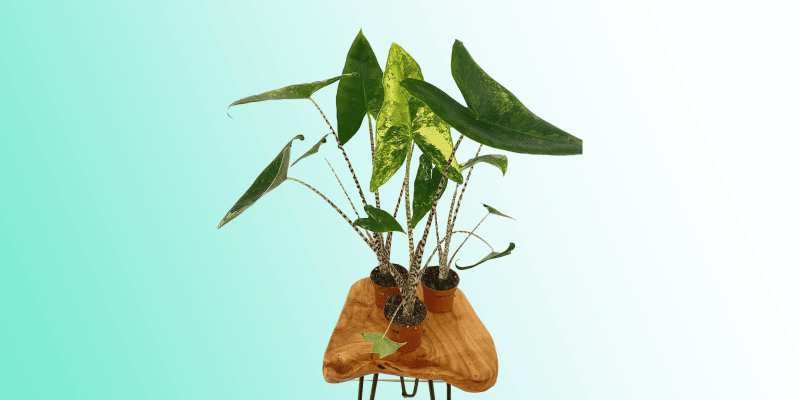Ever heard of a plant with a stem that resembles a zebra’s pelt? Welcome to Alocasia zebrina, a striking elephant ear plant with markings you don’t see every day. Light green stems with intricate black and brown stripes make this tropical plant a stunner.
Curious about how tall this beauty gets or how to propagate it for yourself and others? Read on for essential Alocasia zebrina care tips, propagation methods, and a quick story of how this plant was discovered.
Table of Contents
Alocasia Zebrina Care Guide
History, habitat, and characteristics
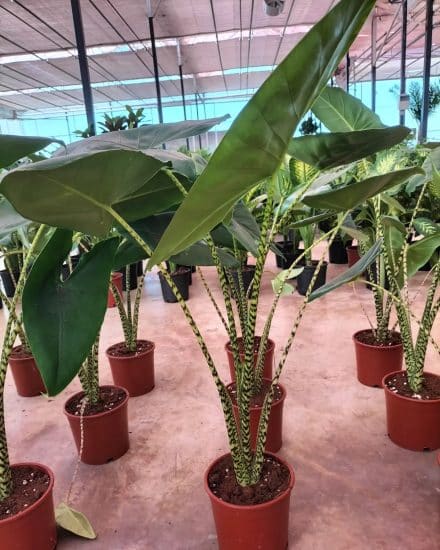
Alocasia zebrina, also known as the Zebra Alocasia or Elephant Ear Zebrina, is an evergreen herbaceous perennial originating in the tropical forests of the Philippines.
The story of this beloved houseplant begins with European horticulturist J.G. Veitch, who discovered Alocasia zebrina in 1862 during a visit to the Philippine Islands. The Proceedings of the Royal Horticultural Society published his description of the plant’s distinct markings and features, calling it both “snake-like in marking” and “curious and handsome.” I agree—who wouldn’t?
This member of the Araceae family earned its nickname, “Zebra Plant,” for its iconic zebra-stripes – light green stems with brownish/black patterning. (It’s also known as “Taro Tiger” in Tagalog. I’m sensing an animal theme here).
This plant features thick veins with arrowhead leaves that grow from a central corm, similar to a bulb that stores food for the plant.
Alocasia zebrina can grow up to five feet high in ideal conditions but they usually top out at around a three-foot spread. It’s a fast grower, especially in the spring and summer months.
Fascinating fact: The Alocasia zebrina plant can produce unisex flowers, which means they only have one set of organs, either male (anther) or female (pistil), and need to be fertilized, or cross-pollinated, by a second Alocasia. After that, they flower and produce a berry, which contains seeds you can use to propagate!
Varieties
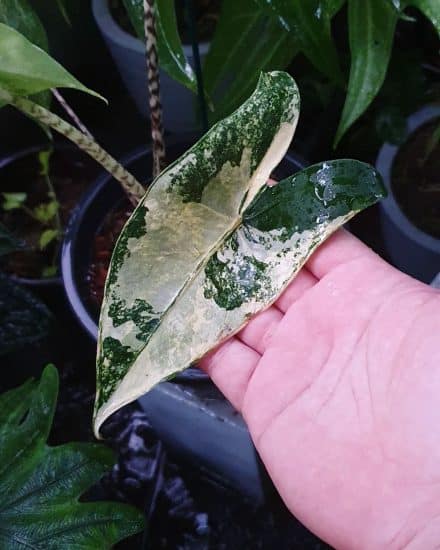
Although all four varieties of zebrina plant may be marketed as hybrids, there are really only two, and two cultivars. What are they?
- Alocasia Giant Zebra: Yes, this is its real name. It’s a jumbo hybrid made by crossing the original plant with Alocasia macrorrhiza ‘Borneo Giant.’ It looks the same, just bigger . . . a lot bigger.
- Alocasia Sarian: This plant is a hybrid of Alocasia zebrina and Alocasia micholitziana. It still retains its namesake striped stems, but throws in the micholitziana’s wavy leaf edges and stark white veins.
- Alocasia zebrina ‘Tigrina Superba’: Sometimes referred to as Alocasia Tigrina, this plant is not a new species, but actually a variety of zebrina with pointier, larger leaves than the original.
- Alocasia zebrina ‘Reticulata’: Sometimes called Alocasia reticulata, this plant, too, is really a cultivar of Alocasia zebrina (people seem fond of inventing made-up new Alocasia species!). It’s got the usual gorgeous patterned stems and an intricate layering of dark and light green stripes on its leaves.
Light
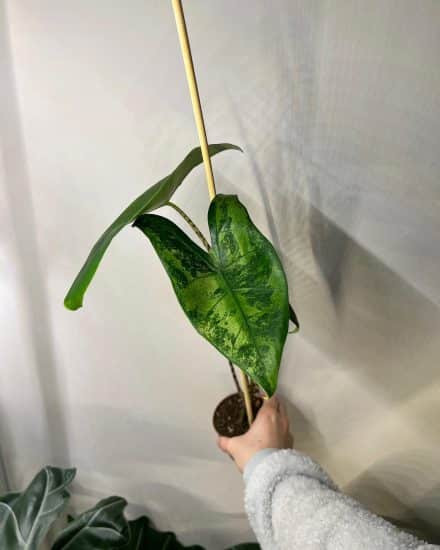
Alocasia zebrina requires bright but indirect light in order to thrive. Avoid putting it in direct sun, as it may cause scorching of the leaves. If you have your plant near an exposure with bright direct light, like a south-facing window, put it a few feet farther back and consider using a sheer curtain to filter out direct sunlight that can damage its foliage.
Turn your plant’s pot 90 degrees every week or two to ensure that all of its leaves receive equal sun (this goes for any plant, not just Alocasia zebrina). This will help growth remain even and symmetrical.
Monitor the leaves of your Alocasia zebrina for signs of too much or too little light: Too little light will cause your plant to become lanky and sparse, while too much will cause brown spots on the leaves and edges.
Leaf yellowing or fading is often caused by a lack of light, both natural and artificial. To remedy this, try positioning the plant in an area with bright and indirect sunlight or introducing artificial lighting to improve photosynthesis. If your plant does not get enough light, you can supplement it with a full spectrum or LED grow lamp at around approximately 1000-3000 lux.
Water
When it comes to taking care of an Alocasia Zebrina, water is key. These plants should be kept in moist soil, but not soggy.
To check if it’s time to water your Alocasia Zebrina, use the finger test: poke the soil up to two inches deep and feel if it’s damp. If it isn’t, give your plant a good soaking. As a general guideline, summer months are usually the time of fastest growth, so you may need to water your plant up to once a week then.
In the winter you’ll find that you have a dormant plant, so you can decrease watering to every 10-14 days. It may seem counterintuitive to water your plant less, but dry periods during winter are actually beneficial for it! Alocasia Zebrina has tubers that store energy, allowing the plant to bounce back with proper care when spring and summer roll around again.
It’s important to make sure that the soil doesn’t become dry, but also that it isn’t too wet. Overwatering can drown the roots and cause root rot, while underwatering will cause the leaves to turn yellow and eventually drop off. Keep in mind, it may take a few tries before you understand fully how much water the plant needs to stay healthy—and that’s okay!
Tip: Your plant enjoys icy cold showers as much as you do, so use lukewarm water when watering to avoid shocking it!
Temperature and humidity
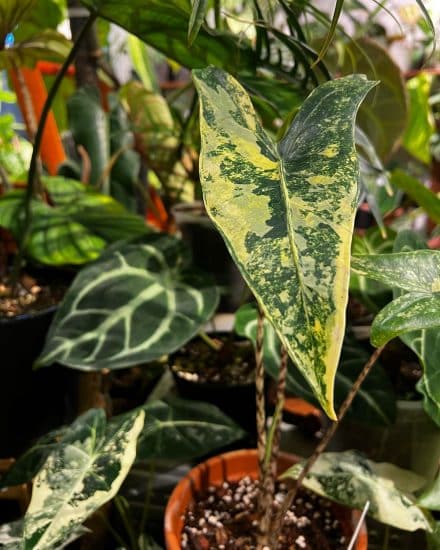
The Alocasia Zebrina is a tropical plant, so it prefers warmer temperatures and higher levels of humidity in its natural environment. This plant does best in temps ranging from 60-80°F.
Avoid large changes in temperature, either too hot or too cold, to prevent the risk of wilting or leaf drop. If you think the temperature could be affecting your Alocasia, you’ll have to play detective and check if it’s near an air duct or drafty window.
Alocasia Zebrina is a fan of humidity, so you’ll have to work to get it just right; aim for anywhere between a minimum of 50% and a max of 70%. If you live in a particularly dry climate, increase humidity by:
- Using a humidifier
- Set up a tray of water/pebbles near the plant. Just make sure to top up the water when it dips lower than the pebblesisc
- Moving the plant to a bathroom where the steam from a hot shower will work wonders (but make it a temporary move if your bathroom doesn’t have enough light!)
- Grouping plants with similar needs together to share humidity in a process called transpiration
Soil and planting
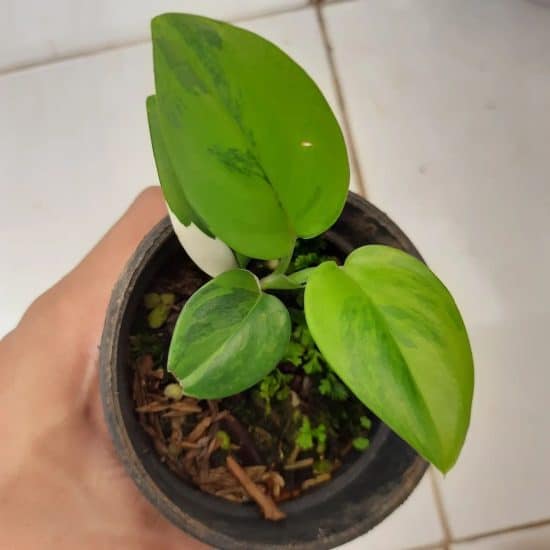
Alocasia zebrina requires a soil mix that retains moisture, drains well, and is stocked with nutrients essential for growth. While there is no one holy grail soil mixture, it should contain a natural mix of potting soil and organic material. An ideal soil mix for your alocasia zebrina could include:
- 50% houseplant potting mix – serves as a foundation for the mix and provides nutrients to the plant
- 20% sphagnum moss or coco coir – helps retain moisture
- 20% perlite – adds texture and aeration
- 10% orchid bark – helps drainage
Consider using other percentages and materials depending on your plant’s preferences and your watering style. For instance, if your mix seems too dry, you could add more coco coir to up the moisture quotient.
It’s an experiment! Don’t be afraid to switch soil components up until you find what works well for you and your plant.
Fertilizing
Fertilizing once a month with diluted, balanced all-purpose liquid fertilizer will help keep your alocasia zebrina healthy and thriving. Feed every other week in the summer and not at all in the winter. Fertilizing your plant when it isn’t actively growing (aka dormant) could harm its roots.
Pruning
The Zebra plant sheds its bottom leaves naturally as it directs more energy to new leaves emerging at its top. You should prune these with a sterilized pair of sharp shears or scissors to maintain its appearance and help it channel the energy its new leaves require.
(Tip: Don’t cut off a leaf that isn’t fully dead yet, since your plant will still be reabsorbing its nutrients. Wait until a leaf is fully dry and crisped before removing it.)
Repotting
Alocasia zebrina thrives while root bound, so you can be a bit lazy with repotting and only if you’re looking to maximize its growth potential. If you are going to repot, consider doing it at the same time as propagation to keep stress minimal.
When repotting, gently untangle the root system out, as Alocasia zebrina prefers a loose soil and root system.
Choose a wider, shallow pot with sizable drainage holes. This type of pot will provide more room for the roots to expand, allowing for greater amounts of root aeration.
Propagation guide
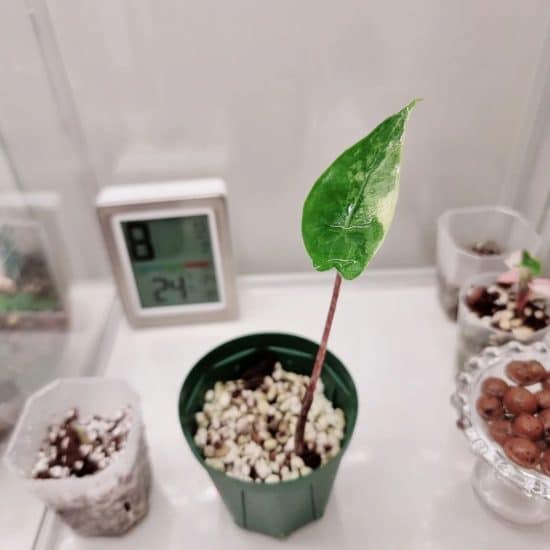
Since Alocasia zebrina doesn’t have true stems, but grows blades from a central corm, stem cuttings aren’t an option here. But you can harvest corms or divide its rootball. Each method has its pros and cons. Both techniques require a mature, healthy plant and are best done while repotting.
Propagate your zebrina plant by division if: you want an easy and inexpensive method that produces mature plants quickly. Keep in mind that each root division you make has to be large enough to support the new plant, so if you have a younger zebrina, this may not be the ideal route.
Propagate by corm harvesting if: you have an older plant with corms to spare and/or your plant is difficult to divide (its roots are very entangled). Keep in mind that this option takes more time and patience than the division method to produce mature plants.
To propagate your Alocasia zebrina by division:
- Gently remove any excess soil from the roots and ensure each intended division has a few roots of its own.
- Use a sharp, clean knife to make vertical cuts, dividing the roots.
- Plant them in the same soil (or even pot) as the mother plant. Moisten the soil regularly, making sure not to overwater.
- Place your newly potted Alocasia Zebrina in bright indirect light and gradually increase the amount of light it receives as it develops.
To propagate Alocasia Zebrina by corm harvest:
- Examine the soil for round bulb-like masses. The older your plant is or the more time that’s passed since you repotted it, the more corms it will have. Some will come off easily, but others might be still attached to the mother plant. If this is the case, simply snip them off where they’re connected.
- When harvesting corms, peel the hard outer layer, or tunic, off and place the bare corm half-submerged into a small vessel with water. Aloha Plant Life has a fantastic video about the entire corm harvesting process and suggests using bottlecaps! Make sure the corm is facing up with the pointy tip up and the rough side down.
- Cover the bottlecaps or other vessels with an upside down glass to trap humidity and place both in an area where they will receive lots of light.
- Within the next six weeks, the corms will curl outward in fleshy layers that look almost like small white rose petals. They’re preparing for the first leaf to emerge!
- Soon after, you’ll see small white roots developing below and the first leaf push out. When the roots starts getting longer, if you were using a bottle cap, you can move the corm to a small water jar.
- Once roots are well-developed and the first leaf is fully unfurled, go ahead and plant the corm in chunky, well-draining soil. Give it lots of humidity and keep the soil evenly moist. Congratulations, you’ve successfully propagated your Zebra plant!
Common Issues
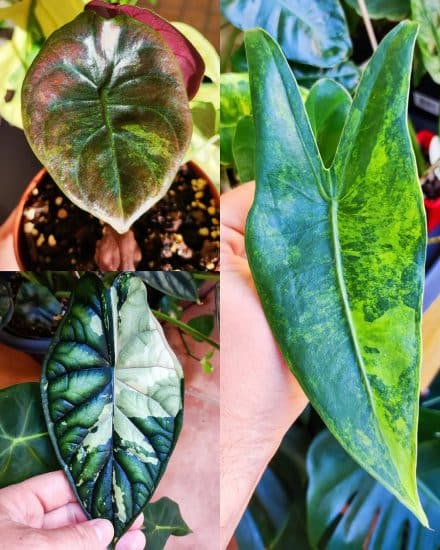
You’re a division and corm propagation specialist by this time, but what happens when issues like yellowing leaves or unwanted bugs strike? Don’t panic: there are tried and true solutions to common Zebra plant problems coming up next.
Brown or yellow leaves: A common issue with Alocasia zebrina plants is leaf discoloration. Yellow or brown leaves can occur due to improper lighting, too much or too little water, or nutrient deficiencies. To ensure your alocasia is receiving enough light, place it in a bright spot with indirect sun exposure. To gauge the water and nutrient levels, check the soil’s moisture —if it’s too wet, move the plant to a pot with better drainage and allow it to dry out before watering it. If it’s too dry, increase the plant’s watering frequency. If the discoloration persists, you can take a soil test to check for any trace nutrient deficiencies and fertilize accordingly.
Leaf Curling: Leaf curling is a sign of too little humidity. To increase the humidity levels around your Alocasia zebrina, you should mist the leaves with water (this will help temporarily) or place a humidifier nearby. You should also move the plant away from drafty windows and doors or any heat sources that could be drying out the plant.
Stunted growth: If your Alocasia isn’t getting any taller, it might be time to repot. Check for compacted roots. Also look out for loose soil with too much sand, which means your plant doesn’t have the nutrients or moisture to grow.
Drooping leaves: You can use a soil meter to determine if a wilting plant is the result of either too much or too little water. If it’s dry, give it a good drink, and if it’s wet, leave it alone until it dries out.
Diseases and pests
Taking care of Alocasia zebrina doesn’t have to be a challenge, but there are some common diseases and pests you should watch out for.
Root Rot. Unfortunately pretty commonly found in Alocasia zebrina and caused by overwatering the soil or using soil that compacts too easily. If you’re noticing spotting on the leaves, soggy soil, and notice mushy, white roots when you investigate you can be pretty sure it’s root rot. The best prevention is to only water when it’s dry. To treat the plant: cut away any infected parts of the plant and replant in fresh soil. Make sure the mix you use drains quickly and cut back on the watering. Disinfect any tools used with rubbing alcohol or by boiling.
Fusarium wilt. Leaves wilting and veins yellowing on both sides of your leaves? Fusarium wilt could be the cause. It’s caused by a whole range of different fungi, but Fusarium oxysporum is the main one responsible. It also exhibits a white and yellow streaking of the root or rhizome in some cases. Treat it with a fungicide containing fosetyl-Al or mefenoxam. This should be applied carefully to the entire plant as well as the soil, while avoiding contact with the plant’s leaves. It may be necessary to do this multiple times, with an application every 10 days, to ensure the fungus has been completely eradicated.
Leaf spot disease. This takes the form of moist dark black or brown spots, sometimes surrounded by a yellow ring, that will spread and eventually lead to leaf death if not treated. What to do next? Isolate the affected plant from others and treat it with a mix of baking soda (a half teaspoon per gallon) and water, wiping your zebra plant’s blades thoroughly. Alternatively, you can buy a treatment from a plant store that contains copper octanoate and sulfur.
Bugs. Alocasia zebrina is susceptible to infestations from a variety of common houseplant pests, such as aphids, spider mites, fungus gnats, and mealybugs. Pay attention to the leaves and stems, and give your Alocasia zebrina a routine cleanse with a solution of soapy water. Spraying your plant with the solution every two weeks should help keep those pests away. If you find an issue, isolate the plant from the rest and spray its blades back and front with insecticidal soap or light horticultural oil. Repeat every five to 10 days until the problem is resolved.
Conclusion
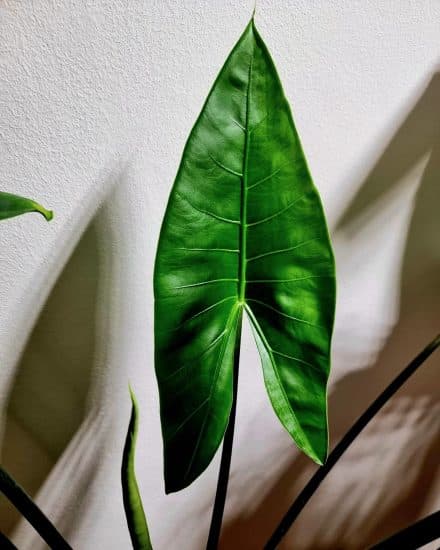
And there you have it—all the details about the bright indirect light, humid climate, and well-draining soil mix your Alocasia zebrina craves. Keep in mind that while it’s not possible to propagate this plant with stem cuttings, division and harvesting corms are the two most popular methods, and neither are terribly difficult.
What are you waiting for? Get to making more little zebrinas!
If this article was helpful to you, consider sharing it with a friend. Get in touch with us any time on Twitter or Facebook to ask questions or tell us about your plant journey.
FAQ
Is Zebrina Alocasia rare?
While zebrinas aren’t considered difficult to come by in plant stores, they are included on the National List of Threatened Species put out by the Department of Environment and Natural Resources of the Philippines. That’s why propagating is even more essential!
Is Alocasia zebrina safe to touch?
Like all alocasias, the zebrina produces calcium oxalate crystals on its stems and leaves, which are toxic to humans and animals, so keep it out of reach of your little ones and fur babies.
Is alocasia zebrina an indoor plant?
Yes! As long as you mimic its natural habitat and give it high humidity, lots of bright, indirect light (think filtered through a jungle canopy), and moist but not sopping soil, this plant can thrive inside any home.
Sources
- https://powo.science.kew.org/taxon/urn:lsid:ipni.org:names:77177187-1/general-information
- https://www.biodiversitylibrary.org/page/11264994#page/458/mode/1up
- https://philjournalsci.dost.gov.ph/home-1/39-vol-142-no-3-special-issue-2013/758-role-of-light-in-the-life-stages-of-mt-makiling-populations-of-alocasia-zebrina-an-endangered-philippine-plant-species
- https://bmb.gov.ph/index.php/facts-and-figures-wild/national-list-of-threatened-flora

